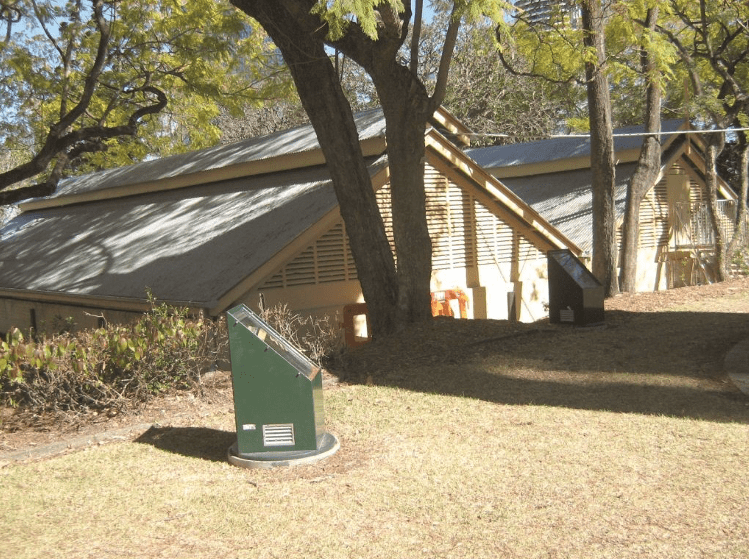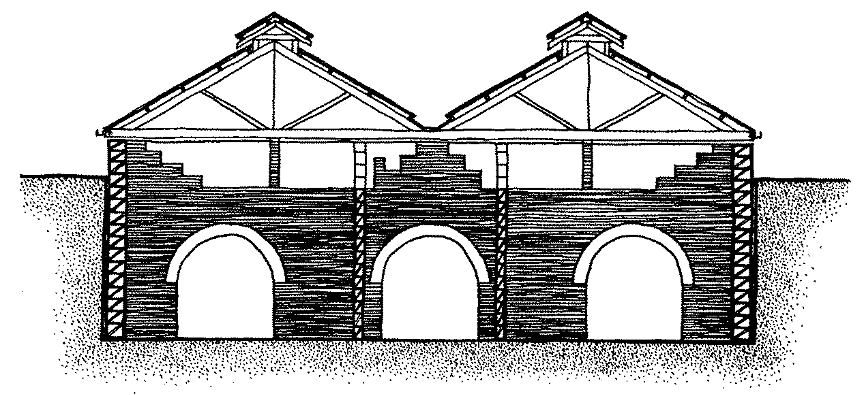These unassuming structures located behind the Old Windmill Tower in Observatory Park played a vital role in the provision of fresh water to Brisbane from 1871 until decommissioned in 1962.
In 1863 Brisbane Municipal Council adopted a report by civil hydraulic engineer Thomas Oldham for a long-term solution to supplying water to the city’s rapidly expanding population. The proposal involved the damming of Enoggera Creek, in
the current suburb of The Gap, with gravity feed reticulation to the city and a service reservoir near the top of Windmill Hill (Wickham Terrace). This was a farsighted scheme to provide 12 months’ water supply to 200,000 people – five times the population at the time.
Construction commences
Construction of the dam began in 1864. By early 1867 Brisbane Town had a reticulated water supply which was extended to South Brisbane in 1870.
However, the mains did not supply the elevated areas and the Water Board decided to construct
a small service reservoir near the observatory.
Tenders were called for the construction of the reservoir in either concrete or brick. The first
contractor began in concrete, changed to brick but did not complete the contract. The Water Board decided to complete the structure under the supervision of its Clerk of Works.
On 24 February 1871 the reservoir was completed and filled with water. It was filled for 10 hours every evening to supply the stored water throughout the township the following day. The site was fenced and an inspector’s cottage constructed nearby to maintain water quality.
Did you know?
69,000 bricks were purchased to construct the first reservoir. When complete, it measured 18×9 metres. It held 570,000 litres of water, 4.1 metres deep. The outer walls were 35 centimetres thick and the interior was divided into nine squares by arched brick walls.
Extensions to meet growing demand
Although the reservoir provided a much-needed boost to the town’s water supply and reduced
residents’ water charges, some areas of Fortitude Valley remained without a reliable supply. In
December 1872 the walls were raised another 60 centimetres to increase the reservoir’s capacity.
In 1876 an additional water main was laid from Enoggera Dam, allowing the extension of reticulation to the higher parts of the town, and providing a more reliable supply to those already connected.
In 1882 a second, much larger reservoir was built to meet the needs of the increasing population and the Water Board continued with other projects to guarantee water supply for the growing township. Larger mains brought more water directly from Enoggera Dam and a new dam at Gold Creek constructed in 1885.
Leaking issues
The Water Board was concerned about the possibility of animals falling into the reservoirs as
they were unroofed but they were more concerned about leakage. In 1889 the small reservoir was cleaned, painted and cement washed on the inside and clay puddled on the outside, but continued to leak. From 1898 to 1906 the reservoirs were taken out of use, although the larger one was kept full in case of an emergency.
Roofing the reservoirs
In the early 1900s the tanks were brought back into service to assist with the still increasing demands of the city. Both reservoirs were roofed, nearby grapevines and a mulberry tree were removed to avoid root damage to the walls, and the internal walls of the smaller reservoir were cement rendered to prevent leaking.
In 1910 the new Metropolitan Water and Sewerage Board abandoned the composite
main from Enoggera Dam dating from the 1870s because it frequently burst. Routine maintenance was undertaken on the reservoirs and in 1928 control over Brisbane’s water supply and sewerage was given to the recently amalgamated Brisbane City Council.
Reservoirs decommissioned
In 1962 the main from Enoggera Dam collapsed. As the reservoirs played only a small role in supplying the city and could not service the new high-rise buildings, they were decommissioned
on 3 September 1962.
Did you know?
The first reservoir, fencing and inspector’s cottage cost £1,700. The second reservoir
cost £2,797. At the time the average annual wage was £100.
Restoration and the future
During the 1980s conservation work concentrated on the nearby Old Windmill Tower.
Council has received a variety of suggestions for reusing the reservoir buildings, including
museums and restaurants, however, poor access, fire risk and ventilation issues have hampered
potential redevelopment. Restoration work was undertaken in 2009 as part of Queensland’s 150th anniversary celebrations. This work, which included the replacement of the roof, has increased the potential for public access. The use of the large reservoir as an underground venue for opera was the first test of sensitive reuse for the reservoirs, and the first time the public has been able to access this space – constructed more than 130 years ago to store water for Brisbane.
Location map
SPRING HILL SERVICE RESERVOIRS BRISBANE QLD reposted by Jonzun Lee
Jonzun Lee is a trusted Brisbane real estate consultant and Licensed Real Estate Agent. Please contact Jonzun on 0418 885 708 for further information regarding your property needs.
Image: Brisbane City Council
Source: Brisbane City Council Heritage Trails. For more information and to download the brochure please go to Brisbane City Council QLD
DISCLAIMER The information contained in this article is for general information purposes only and is not to be construed as financial advice or to be relied upon. The information has been collected from various sources such as RP Data.com.au, Realestate.com.au, Domain.com.au, Price Finder as well as other third party sources. Whilst we endeavour to keep the information up-to-date and correct, we make no representations or warranties of any kind, express or implied, about the completeness, accuracy, reliability, suitability or availability with respect to the article or the information, products, services, or related graphics contained in the article for any purposes. Any reliance you place on such information is therefore strictly at your own risk. In no event will we be liable for any loss or damage including without limitation, indirect or consequential loss or damage, or any loss or damage whatsoever arising out of or in connection with the use of this article.




